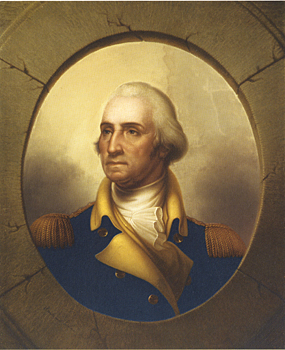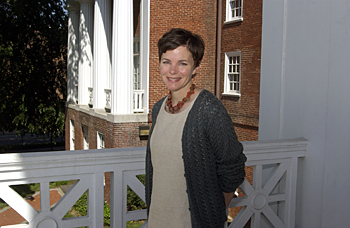Being invited to give the lecture was an honor, Bellion said. The Rubin Lectures, held annually since 1988, bring scholars to the Metropolitan to present new research in American art history. Bellion's talk was well-attended, with about 350 persons present, and was followed by a reception at the Temple of Dendur in the Egyptian wing of the museum.
Much of Bellion's research focuses on trompe l'oeil, or the optical illusion of reality in paintings, and Rembrandt Peale's portrait of Washington falls into that category, Bellion said. “It is an idealized portrait and a composite of other portraits of Washington that were done when he was alive. The trompe l'oeil frame is crucial because it helps create the fiction of a living, breathing Washington.
“It was painted at a time of great nostalgia for Washington and the Revolutionary generation, with the 50th anniversary of the signing of the Declaration of Independence coming up in 1826 and the Marquis de Lafayette returning to the U.S for a triumphal tour of the country,” she said.
Known as the “porthole portrait,” the painting depicts Washington surrounded by an illusionary masonry frame that is etched with the words “Patriae Pater” (Father of his Country). The portrait was highly successful and bought by Congress in 1832. Peale himself painted 70 copies or versions of the portrait and also produced a critically acclaimed lithograph.
Peale painted the portrait as a marketing tool, Bellion said, hoping to persuade Congress to commission him to do an equestrian portrait of Washington. Although he did not receive the commission, he did paint an equestrian portrait, as well.
Bellion said that Peale hoped his Washington paintings would rival Gilbert Stuart's unfinished “Athenaeum” portrait of George Washington, which appears on $1 bills.
Bellion, who also has studied Peale's father, John Willson Peale, is completing Citizen Spectator: Art, Illusion and Discernment in Early National America, which is scheduled to be published by the University of North Carolina Press for the Omohundro Institute of Early American History and Culture. The book will examine the exhibition of trompe l'oeil paintings, optical instruments and mechanical deceptions within the political culture of the post-Revolutionary United States.
Some of the devices used include solar microscopes, which projected magnified insects and other small objects onto walls, and camera obscura, which projected images through a tiny opening using a lens into a totally darkened room.Magic lanterns, which used candles to project glass slides onto walls, also were popular in theatres and museums. When a French showman came up with the idea of putting the magic lantern on wheels, an early form of the moving image was invented--the phantasmagoria, which projected ghosts, skeletons and corpses that appeared to hover and dance before the spectators' eyes, Bellion said.
One of the most popular phantasmagorias in the U.S. represented George Washington rising from his tomb at Mount Vernon. Bellion said that something similar is at work in the "porthole” portrait. The trompe l'oeil painting reproduces the visual effects of the phantasmagoria, working to persuade the spectator that Washington is nearly within reach, she said.
Recently, Bellion and Monica Dominguez Torres, assistant professor of art history, have received grants from UD's College of Arts and Sciences and Center for International Studies, to prepare for an international symposium, “Colonial Art and Art History Across North America.” The event will include speakers from Mexico, Canada and the United States and will be held in the spring.
Bellion is on the faculty of UD's Center for Material Culture Studies and UD/Winterthur Program in American Material Culture. She is a graduate of Wesleyan University and received her master's and doctoral degrees from Northwestern University. She was a National Endowment for the Arts fellow at the Omohundro Institute of Early American History and Culture and visiting assistant professor at the College of William and Mary and taught at Rutgers University before coming to UD in 2004.
Article by Sue Moncure
Photo by Sarah Simon




